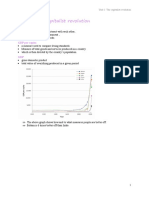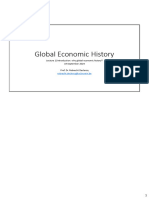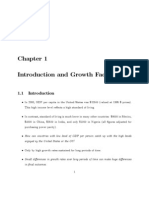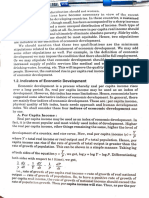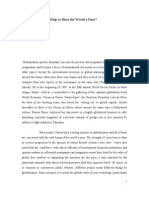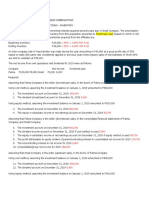1 - The Capitalist Revolution
1 - The Capitalist Revolution
Uploaded by
Haoyu WangCopyright:
Available Formats
1 - The Capitalist Revolution
1 - The Capitalist Revolution
Uploaded by
Haoyu WangOriginal Description:
Copyright
Available Formats
Share this document
Did you find this document useful?
Is this content inappropriate?
Copyright:
Available Formats
1 - The Capitalist Revolution
1 - The Capitalist Revolution
Uploaded by
Haoyu WangCopyright:
Available Formats
💸
1 - The Capitalist Revolution
Income Inequality
Economically speaking, the world was flat a thousand years ago. When it comes to
income, nobody thinks the world is flat in this day and age.
Figure 1.2: Countries are ranked by GDP per capita from left to right. For each country the heights of
the bars show average income for deciles of the population, from the poorest 10% at the front to the
richest 10% at the back. The width of the bar indicates the country’s population.
Two things are clear:
In every country, the rich have much more than the poor. The richest 10% earn 5.4
times more than the poorest 10% in the relatively equal country of Norway, while the
same figure is 16 for the US and 145 in Botswana. The same feature exists in poor
countries, with the figure being 22 in Nigeria and 20 in India.
Between countries, there is a huge difference in income: the average income in
Norway is 19 times that of Nigeria. Furthermore, the poorest 10% earn twice as
1 - The Capitalist Revolution 1
much as the richest 10% in Nigeria.
This level of inequality was not observed a thousand years ago, and the same graph
would be much flatter during the times of Ibn Battuta, during his journeys across the
world in the 14th century.
Exercise
What do you think a ‘skyscraper’ figure like Figure 1.2
would have looked like at the time of Ibn Battuta (early to mid-fourteenth century)?
The graph would be a flatland: there would be no skyscrapers. The graph would be
characterised by a gentle hill: the richest and the poorest across countries would
share similar levels of income, with each decile having approximately the same
level of income as their peers in other countries.
In the visualisation, use the ‘Rich/poor income ratios’ tab to find the rich/poor ratio in
1980, 1990, and 2014 for each of your chosen countries.
China
1980 58
1990 79.9
2014 202.9
South Sudan
1980 324.2
1990 324.2
2014 292.2
United Kingdom
1980 78.2
1990 106
2014 115.7
USA
1980 120.8
1 - The Capitalist Revolution 2
1990 173.5
2014 256.6
Malaysia
1980 222.1
1990 206.7
2014 138.7
Describe the differences between countries and the changes over time that you find.
All countries, apart from some outliers, share the common trait of having rising
rich/poor ratios as time goes on. While some have observed this ratio decrease
upon development, this figure soon rose back again. Some countries, such as
China, has seen the ratio Quadruple, while developing areas such as Malaysia have
seen this ratio constantly shrinking.
Can you think of any explanations for them?
Upon development, the income of the poor, despite still being much lower than the
richest ones, rise at a swifter pace than the rich, leading to lowering rich/poor ratios
such as the ones observed in Malaysia. However, since access to capital in
developing countries is only accessible by the rich, the poor are constrained by
factors exogenous from them and soon reach an upward income cap, since they
receive most of their income through labour. The rich, on the other hand, earn their
income through capital, which does not suffer the same time-limitations as someone
receiving income through labour. This leads to rising income in developed countries,
such as the UK and the USA.
Measuring Income and Living Standards
The most common used metric is GDP per capita. GDP measures the market value of
the output of final goods and services in the economy in a given period. Output of
intermediate goods that are inputs to final production is excluded to prevent double
counting. When everything is summed up, the total value of the goods produced by an
economy is reached, hence everyone’s income. When GDP is divided by population,
GDP per capita gives the average income of all people in the country. However:
1 - The Capitalist Revolution 3
GDP per capita measures average income, which is different from disposable
income. Disposable income measures all forms of income, such as wages, profit,
rent, interest and transfer payments, minus any transfer to others, such as taxes to
the government. Disposable income is considered to be a good measure of living
standards because it is the maximum amount of goods or services a person can
buy without having to borrow
However, disposable income leaves out qualitative factors such as:
Quality of our social and physical environment: friends or clean air
Free time to relax or spend with family or friends
Goods and Services that are not bought, such as healthcare or education
Goods and Services that are produced within the household
However, it is important to distinguish average disposable income from average
wellbeing. For instance, if resource distribution is highly concentrated on a tiny
fraction of a population, then the overall wellbeing of a group with greater average
income but concentrated towards a tiny fraction of the population is likely to be
lower than a more evenly income distributed group whose average income is lower.
So although absolute income matters, people also care about their relative position
in the income distribution: lower wellbeing are experienced the lower down they are
in the group. Therefore, average income may fail to reflect how well off a group of
people are compared to another one.
GDP per capita may be a better measure of welfare because it includes services
such as defence and education which is not included in disposable income figures.
Exercise
In the full text, which goods does he list as being included in a measure of GDP?
Air pollution, cigarette advertising, and “ambulances to clear our highways of
carnage”. Special locks for doors and the jails for the people who break them. The
destruction of the redwood and the loss of natural wonders in chaotic sprawl.
Napalm and nuclear warheads, armoured cars and police fighting riots in cities.
Whitman’s rifle and Speck’s knife. Television programs glorifying violence in order to
sell toys to children.
Do you think these should be included in such a measure, and why?
1 - The Capitalist Revolution 4
Yes. The purpose of GDP is to serve as a purpose of overall welfare. The goods
listed by senator Kennedy exist for a purpose, and although they are not beneficial
for society as a whole, nor the individual in the short term, they are pursued in order
to increase personal welfare. So although flawed, these items should still be
included in such a measure.
Which goods does he list in the full text as missing from the measure?
The health of children, the quality of their education nor the joy of their play. The
beauty of poetry nor the strength of marriages. The intelligence of public debate nor
the integrity of public officials.
Do you think they should be included, and why?
I think they should not be included in GDP. This is because GDP is a statistic to end
all statistic, and statistic does not allow room for qualitatively measured expressions
of happiness such as “happiness”, which is what it is attempting to measure in the
first place. Furthermore, one could argue that such measures are already included
this statistic in some capacity: the intelligence of public debate may be served by
the proxy of education spending in such area, and the strength of marriages by
honeymoon trips.
What Does UK GDP Per Capita Measure?
The total output of the UK’s economy, divided by the country’s population.
History’s Hockey Stick: Growth in Income
The growth rate is the change in income/original level of income.
If the growth fo countries is to be compared, the ratio scale, defined as the a scale
following a logarithmic behaviour, with the scale doubling for every equal increment in y
axis gains. This is because, if the country (a series) grows at constant rate, a straight
line is observed, since the percentage change, or the proportional growth rate, is
constant. Obviously, steeper lines mean a faster growth rate.
1 - The Capitalist Revolution 5
GDP per Capita of countries using the ratio scale. Two things are evident here: For a very long time,
there was no substantial growth in living standards, and that when sustained growth occurred, it began
at different times in different countries, hence the vast differences in living standards around the world.
💡 Some economics have only experienced substantial improvements in living
standards only when gained independence from colonial rule from European
nations
Adam Smith
Wrote “An Inquiry into the Nature and Causes of the Wealth of Nations”, of which main
ideas are:
The invisible hand, where the businessman “‘intends only his own gain, and he is in
this, as in many other cases, led by an invisible hand to promote an end which was
no part of his intention. Nor is it always the worse for the society that it was no part
1 - The Capitalist Revolution 6
of it. By pursuing his own interest he frequently promotes that of the society more
effectually than when he really intends to promote it.”
Individuals’ pursuit of self interest: “It is not from the benevolence of the butcher, the
brewer, or the baker that we expect our dinner, but from their regard to their own
interest”
Specialisation leading to great increases in efficiency: the pin factory producing
50,000 pins a day, but “if they had all wrought [pins] separately and independently
… they certainly could not each of them have made twenty, perhaps not one pin in a
day”
But apart from self-interest, Smith also believed that people where guided by moral
sentiments, hence publishing the book “The Theory of Moral Sentiments”
He also though that the market had some failings, especially during collusion: “People in
the same trade seldom meet together,’ he wrote, ‘even for merriment and diversion, but
the conversation ends in a conspiracy against the public; or in some contrivance to raise
prices.”
He was an advocate for the government to protect the nation and to ensure justice, as
well as investment in education and public works.
Exercise
For Britain, identify a period of time when its growth rate was increasing and another
period in which its growth rate was roughly constant. Which figure did you use, and
why?
A period of increasing growth rate was during the two industrial revolutions around
the 19th century, where growth was high and constant. Any time before this, for
instance, from 1400 to 1600, growth was mostly constant. I chose these figures
because it follows the narrative that economic systems and ideologies have great
impact on the economy, and these two time periods are real-world proof of the
consequences of ideologies on the economy.
Identify a period during which GDP per capita was shrinking (a negative growth
rate) faster in Britain than in India. Which figure did you use and why?
It appears that a short period (early 1700s) there is a negative spike for the UK
while for India where is slow steady decline in the per capita real GDP. I used the
1 - The Capitalist Revolution 7
ratio scale graph (figure 1.1b) since the slope of the variable measured in
logarithms equals the growth rate.
The GDP per capita of Greece was $22,494 in 2012 and $21,966 in 2013. Based on
these figures, the growth rate of GDP between 2012 and 2013 (to two decimal places)
was:
-2.35%
Imagine that the GDP per capita of a country had doubled every 100 years. You are
asked to draw both linear and ratio scale graphs that plot GDP on the vertical axis,
and the year on the horizontal axis. What will be the shapes of the curves?
An upward-sloping straight line on a ratio scale graph means that the growth rate of
the GDP per capita is constant. An upward-sloping convex curve on a linear scale
graph means that the GDP per capita increases by a greater and greater amount in
absolute terms over time, consistent with a positive constant growth rate.
The Permanent Technological Revolution
It was only until the eighteenth century that each new generation could look forward to a
different life that was shaped by new technology. Before then, there would not be any
measurable change in the standard of living of an ordinary working person.
Everyday usage “technology” refers to machinery, equipment and devices developed
using scientific knowledge. In economics, technology is a process that takes materials
and other inputs, leading to an output. For instance, the technology for making a cake is
the recipe specifying the combination of inputs, leading to an output.
1 - The Capitalist Revolution 8
The creation of light grew ever more efficient, starting from very slow to a sudden up-kick
The speed of information travel: technology led to a great change in the way information is exchanged
1 - The Capitalist Revolution 9
Technology has reduced the amount of work-time it takes to produce the things we
need, allowing for significant increases in living standards. It has also created an ever
more connected world.
The Economy and the Environment
One way of thinking about the economy: a part of a larger social system, itself part of the biosphere.
Through most of their history, humans have regarded natural resources as freely
available in unlimited quantities (except for the costs of extracting them). However, with
soaring production, so did the pace of degradation of the natural environment.
From global climate change to local resource exhaustion, the effects are mostly a result
of both the expansion of the economy as well as the structural reorganisation of the
economy. Yet the permanent technological revolution, which originally moved humanity
towards fossil fuel dependency, may also be the answer to the problem. For instance,
through technological progress, humans have been able to bring more light for less
heat, conserving natural resources throughout the process.
1 - The Capitalist Revolution 10
Exercise
Describe the effects of these exceptionally cold periods on the economies of these
countries.
Humans experienced greater illness and famine. Livestock survival and crop
productivity decreased. The cost of food increased due to shortages and low crop
yields.
Within a country or region, some groups of people were exceptionally hard hit by the
climate change while others were less affected. Provide examples.
The country’s poorest would suffer the most. This is because colder temperatures
during the ice age would heavily influence the amount of crop yield, of which the
country’s poorest rely upon the most. Consequently, the sudden reduction of crop
yield, compounded with the originally lacking amount of saving, means that the poor
would not have adequate access to both food nor shelter.
How ‘extreme’ were these cold periods compared to the temperature increases
since the mid-twentieth century and those projected for the future?
Compared to the sudden rise in temperatures, the cold periods in question were not
as extreme. In fact, current estimates for temperature rises are much higher at 1.0
C, whereas the coldest periods only saw a 0.6 C deviation from mean temperature.
Future estimates are higher still.
Which of the following variables have followed the so-called ‘hockey-stick’ trajectory
—that is, little to no growth for most of history followed by a sudden and sharp change
to a positive growth rate?
GDP per capita, labour productivity and atmospheric CO2
Capitalism Defined: Private Property, Markets, and
Firms
Hockey stick trends, that is, no growth for most time periods and a sudden up-kick, can
be found in many figures, such as GDP per capita, productivity of labour, connectivity of
various parts of the world and impacts on the economy on the global environment
(Carbon Emissions).
1 - The Capitalist Revolution 11
The eighteenth century saw the emergence of the capitalist revolution and the eventual
global spread of a way of organising the economy that is now known as capitalism.
Capitalism is an economic system characterised by economic institutions organising
the production and distribution of goods and services in an entire economy. Central to
this economic system are:
Private Property: where people can enjoy their possessions in a way that they
choose, exclude others from their use upon wish, dispose of them by gift or sale to
someone else and become their owner. In a capitalist economy, capital goods are
key: equipment, buildings and other durable inputs used in producing goods and
services.
Markets: a means of transferring goods or services from one person to another.
Markets may be different in three respects:
They are reciprocated: one person’s transfer of a good or service to another is
reciprocated by a transfer in the other direction, such as barter or money, or a
promise for a later transfer when using credit
They are voluntary: both transfers are voluntary because the things being
exchanged are private property. So the exchange must be beneficial for both
There is competition: a seller charging higher prices will find that buyers prefer
to buy from other competing sellers
Firms: this is a way of organising production following such characteristics:
One or more individuals own a set of capital goods that are used in production
They pay wages and salaries t employees
They direct the employees through management structures in the production of
goods and services
The goods and services are the property of the owners
The owners sell the goods and services on markets with the intention of making
a profit
The definition of capitalism, as such, refers not to a specific economic system, but to a
class of systems sharing the common three institutions of markets, private property and
firm. Some may say that ice is not really water, but debates about the true meaning of
one concept forget why definitions are valuable.
1 - The Capitalist Revolution 12
Exercise
What does this tell us about the meaning of private property?
Private property gives absolute control to its owner and any exogenous factors
cannot influence this. Its use must be the sole voluntary will of its owner and no-one
else.
Does it apply to people’s homes in your country?
No, this is not the case. This is because private property of this form does not exist
in its pure meaning. In the countries where I have lived in, although private property
entitle an individual to its ownership, there are additional factors which can influence
such ownership, as well as forcing the owner into repression.
What are the similarities and differences between that social networking site and a
market?
The currency in social networking sites are more akin to followers or likes, so fiat
currency, or exchanges, do not occur in their original intended sense. Its evolution,
however, has led to the formation of many similarities, such as different accounts
trading likes and each account being to the sole ownership of the user (obviously,
without considering that all of this is property of the company managing the
platform)
Can you suggest an explanation for why the usage of the term capitalism spikes
when it does?
The rate of information transfer, observed by during recent times and the industrial
revolution, have led to an increased awareness of capitalism as a concept, with
more and more people being exposed to the idea. Another explanation may be its
high efficiency as an economic structure, superior to others of its kind, building it a
reputation known to each individual households.
Why do you think it has remained so high since the late 1980s?
Because its contrasting ideology of marxism has proved to be unrealistic int he real
world and its Utopian promises unattainable within the constraints of planet earth.
Consequently, I think that economists have embraced a “if it ain’t broke, don’t fix it”
approach: capitalism has functioned, although with its flaws, to support sustained
economic growth. As such, the resulting prosperity from this has not induced any
need for another economic structure: hence why staying so high.
1 - The Capitalist Revolution 13
Capitalism as an economic system
In a capitalist system, production takes place in firms. But markets and private property
are important because inputs and outputs are private property, and firms use markets to
sell outputs.
A distinctive aspect of the definition of capitalism as an economic system is that under it
most production takes place using privately owned capital goods that are operated by
workers who are paid wages. This contrasts with government ownership of capital
goods in a centrally planned economy, where private firms and markets are relatively
unimportant.
Capitalism is a system combining centralisation with decentralisation.
The emergence of capitalism has been accompanied by two major changes, both
enhancing the productivity of individual workers:
Technology: firms competing with each other in markets had strong incentives to
adopt and develop new and more productive technologies, and to invest in capital
goods that would have been beyond the reach of small-scale family enterprises.
Specialisation: the growth of firms employing large numbers of workers allowed for
specialisation in the tasks and products on which people worked.
Exercise
1 - The Capitalist Revolution 14
Using our definition, explain whether each of the following entities is a firm by
investigating if it satisfies the characteristics that define a firm. Research the entity
online if you are stuck.
1. John Lewis Partnership (UK) ✅
2. a family farm in Vietnam ❌
3. your current family doctor’s office or practice ✅
4. Walmart (US) ✅
5. an eighteenth-century pirate ship ❌
6. Google (US) ✅
7. Manchester United plc (UK) ✅
8. Wikipedia ❌
The Gains from Specialisation
We become better at producing things when we each focus on a limited range of
activities because:
Learning by doing: We acquire skills as we produce things.
Difference in ability: For reasons of skill, or natural surroundings such as the quality
of the soil, some people are better at producing some things than others.
Economies of scale: Producing a large number of units of some good is often more
cost-effective than producing a smaller number.
Consequently, the level of specialisation in an industry is only limited by the extent of
the market: When the market is very small, no person can have any encouragement to
dedicate himself entirely to one employment, for want of the power to exchange all that
surplus part of the produce of his own labour, which is over and above his own
consumption, for such parts of the produce of other men’s labour as he has occasion
for.”
In markets, two things exist in conjunction:
Competition
1 - The Capitalist Revolution 15
Cooperation: markets allow each of us to pursue private objectives to work together,
producing and distributing goods and services in a way that is better than
alternatives.
Comparative Advantage
Absolute advantage is when both an individual or entity can produce more of
everything than the other when the same amount of resources is implemented
Comparative advantage is when an individual or entity can producing something at
a lower opportunity cost than the other
Exercise
Suppose that market prices were such that 35 apples could be bought for 1 tonne of
wheat.
If Greta sold 16 tonnes of wheat, would both she and Carlos still be better off?
If 16 tonnes of wheat are sold, then Greta would get 560 apples, and be left with 34
tonnes of wheat. If she were to produce 560 apples, she would have to give up 22.4
tonnes of wheat. Since she is now having more than the otherwise, she has
benefited from trade.
What would happen if only 20 apples could be bought for the price of a tonne of
wheat?
Her opportunity cost for apples is 25 apples for one tonne. So if she can only buy 20
apples for one tonne, she would not be able to gain from trade
Capitalism, Causation and History’s Hockey Stick
In science, we support the statement that X causes Y by understanding the relationship
between cause (X) and effect (Y) and performing experiments to gather evidence by
measuring X and Y. So in economics, to understand why things happen, we need to
make causal statements: introducing policy X is likely to cause change Y.
However, since the economy is made up of interactions of millions of people, we cannot
measure and understand all of them, hence making it rarely possible to gather evidence
by conducting experiments. A method of research in economics is a natural
1 - The Capitalist Revolution 16
experiment, where a situation in which there are differences in something of interest
that are not associated with differences in other possible causes.
To ask whether institutions matter for growth in income, many people point to the fact
that capitalism emerged at the same time as the industrial revolution and the upward
turn in hockey sticks. Yet critics may also point out about the enlightenment, which also
predated or coincided with the upturn in hockey sticks. The division of Germany in 1945
would provide a good case for a natural experiment: two populations were separated, of
which both shared the same language, culture and capitalist economy until then. Living
standards in 1936 between East and West Germany were the same. Yet the
introduction of a centralised planned economy deviated the two populations of the same
culture towards different pathways.
The two Germanies. Notice how the west started from a more favourable position in 1950, yet in 1936
the living conditions and standards were the same.
1 - The Capitalist Revolution 17
we cannot conclude form the German natural experiment that capitalism promotes rapid
economic growth while central planning is a recipe for relative stagnation. But we can
infer something more limited: the divergence of economic institutions mattered for the
livelihoods of the German people.
Varieties of Capitalism: Institutions, Governments, and
the Economy
Not all capitalist economies may experience the level of economic growth exemplified
by famous examples such as the UK and the USA. For instance, Botswana and Nigeria
shared the same amount of rich natural resources, yet the difference in quality of their
institutions meant that the former’s success in achieving sustained growth has been
equally matched by the latter’s relative failure.
The Developmental State has played a crucial role in leading the economic take off of
South Korea, with Japan and China being two other famous examples of it. In fact,
South Korea’s take off has seen its government playing a leading role in directing the
process of development, explicitly promoting some industries, requiring firms to
compete in foreign markets and providing high quality education for its workforce.
1 - The Capitalist Revolution 18
Divergence of GDP per capita among latecomers to the capitalist revolution
The figure above shows that in 1928, when the soviet union’s first capitalist revolution
was introduced, it produced steady but unspectacular levels of economic growth. The
previous contrast between West and East Germany demonstrates that capitalism may
work differently in different countries. When central planning was replaced in countries
that once made up the Soviet Union, it turned out that capitalism would not be the ideal
economic system: proof of this is the noticeable dip of its GDP per capita upon the
collapse of the previous superpower. Many economists such as Lisa Cook investigated
the reason why the transition to capitalism in Russia in the 1990s did not lead to
innovation stimulated economic growth. She pointed out that in the late 19th century,
innovations such as light bulb technology, traffic lights, etc., all of which would contribute
to economic growth in Africa, were cut short by attacks and anti-black mob violence.
https://www.youtube.com/embed/z2hj_zfrG6g
1 - The Capitalist Revolution 19
A dynamic economic is one which produces sustained growth in living standards. There
are two aspects in conditions in which capitalism is dynamic:
Economic
Less dynamic capitalist economies may have less secure private properties.
When the enforcement of the rule of law on contracts or expropriation by
criminal elements or by government bodies is weak.
Uncompetitive markets may fail to offer the carrots and wield the sticks that
make a capitalism economy dynamic
Less dynamic capitalist economies also suffer from a lack of meritocracy:
managers who survived because of connections did not become owners or
managers due to their ability to deliver high quality goods and services at
competitive prices.
Political: governments play a leading role in the capitalist revolution. Indeed,
governments are part of virtually every modern capitalist economy, with some
accounting for more than half of GDP. Therefore, a dynamic economic system
combines some of the following:
Private incentives for cost reducing innovation
Firms led by those with proven ability to produce goods at low cost
(meritocracy)
Public policy supporting such conditions, with adequate enforcement
A stable society, biophysical environment and resource base
It is important to point out that undemocratic political systems can co-exist with capitalist
economic structures. For instance, capitalism with undemocratic For instance, China
has implemented a variant of the capitalist economic system, while the government is
not a democracy following conventional definition.
And just as capitalism, democracy may come in many forms. For instance, the head of
state is elected directly by the voters, while others this role is performed by an elected
body, such as a parliament. In some, there are strict limits on how individuals can
influence elections or public policy through financial contributions, while others private
money can have great influence over electoral campaigns, either through lobbying or
bribery.
1 - The Capitalist Revolution 20
Consequently, even the difference in political systems can have a
great influence over the economic performance of a country
Exercise
Look again at Figure 1.10. Which shows a graph of GDP per capita for West and
East Germany, Japan and Spain between 1950 and 1990. Which of the following
statements is correct?
Spain was able to grow at a higher growth rate than Germany between 1950 and
1990.
Look again at Figure 1.11. Which of these conclusions is suggested by the graph?
The contrasting performances of Botswana and Nigeria illustrate that rich natural
resources alone do not guarantee higher economic growth, but that higher quality
institutions (government, markets and firms) may also be necessary.
Economics and the Economy
Definition for economics mainly involves a study of how people interact with each other
and their natural surroundings to produce their livelihoods, and how this may change
over time. Hence, it is about:
How we come to acquire the things that make up our livelihood
How we interact with each other
How we interact with our natural environment
How each of such things change over time
1 - The Capitalist Revolution 21
A model for how the economy is organised
Note also how households are also producing people, and not necessarily also the
production of goods and services (although, unlike firms, they don’t sell their outputs in
the market). All of this takes place as part of a biological and physical system in which
firms and households can make use of their natural surroundings and resources,
ranging from fossil-fuel or renewable energy to the air humans breathe.
Exercise
Suppose you can choose to be born in any time period in any of the countries in Figure
1.1a, 1.10 or 1.11, but you know that you would be among the poorest 10% in the
population.
In which country would you choose to be born?
Former Soviet Union
Now suppose, instead, you know you would initially be among the poorest 10% in
the population, but you would have a fifty-fifty chance of moving to the top 10% of the
population if you work hard. In which country would you now choose to be born?
South Korea
Now suppose that you can only decide on the country and time period of your birth.
You cannot be sure if you would be born in the city or the countryside, would be male
or female, rich or poor. In which time and country would you choose to be born?
South Korea in 2020
1 - The Capitalist Revolution 22
For the scenario in (3), in which time and country would you least want to be born?
Nigeria in 1928
Use this tool to model within and cross country inequality for the countries in the
figures above over the last 4 decades (you can do 7 countries at a time; you need to
pick up the skyscraper and turn it around). Write a paragraph on what you have found
out.
1980
1 - The Capitalist Revolution 23
1990
1 - The Capitalist Revolution 24
2000
1 - The Capitalist Revolution 25
2010
1 - The Capitalist Revolution 26
2020
Incomes across all groups has seen steady rises over the past four decades, yet
countries have grown at different paces than each other. Countries such as
Afghanistan which have suffered exogenous shocks have seen their incomes drop
steadily, while other countries which have observed successful implementations of
capitalism have seen huge increases in inequality. Example of this is South Korea:
from the richest decile earning a little bit more than the second highest in 1980 to
earning more than 3 times the second highest in 2020.
Revision
https://quizlet.com/220557211/flashcards
Assignment
1 - The Capitalist Revolution 27
https://s3-us-west-2.amazonaws.com/secure.notion-static.com/836b41d3-0e0d-4
9e7-9d39-6b616c057aca/espp-1-3-1.xlsx
1 - The Capitalist Revolution 28
You might also like
- Class (1) MicroeconomicsDocument34 pagesClass (1) MicroeconomicsBielNo ratings yet
- Fundamentals of Corporate Finance 13th - Stephen Ross, Randolph Westerfield, Bradford JordanDocument4 pagesFundamentals of Corporate Finance 13th - Stephen Ross, Randolph Westerfield, Bradford JordanHải Nam VũNo ratings yet
- Macro II - Capitulo 9 - Gabarito (Nao Precisa Do Checklist 8 e 12, e Dos Problems B e E)Document10 pagesMacro II - Capitulo 9 - Gabarito (Nao Precisa Do Checklist 8 e 12, e Dos Problems B e E)l1u2i3z4No ratings yet
- Unit 1 (The Capitalist Revolution)Document12 pagesUnit 1 (The Capitalist Revolution)jeannedreyer100% (1)
- Hp12c DurationDocument3 pagesHp12c DurationGabriel La Motta100% (1)
- Gerhart, B. (2017) - Incentives and Pay For Performance in The Workplace. Advances in Motivation Science, 91-140.Document50 pagesGerhart, B. (2017) - Incentives and Pay For Performance in The Workplace. Advances in Motivation Science, 91-140.Charles Manchester100% (1)
- Notes On The Stock-Flow Consistent Approach To Macroeconomic ModelingDocument164 pagesNotes On The Stock-Flow Consistent Approach To Macroeconomic ModelingthesmokingfrogNo ratings yet
- Bernard Lietaer - Global Complementary Currency - The Terra TRC White Paper (2004)Document20 pagesBernard Lietaer - Global Complementary Currency - The Terra TRC White Paper (2004)Local MoneyNo ratings yet
- Game Theory Case StudyDocument8 pagesGame Theory Case StudyPranay KatheNo ratings yet
- Finance and Economic Growth Nexus: Case of ZimbabweDocument23 pagesFinance and Economic Growth Nexus: Case of ZimbabweMoses ChungaNo ratings yet
- Developmental Growth TheoriesDocument41 pagesDevelopmental Growth TheoriesKiran KaleNo ratings yet
- Endogenous Growth Theory: A Critical AssessmentDocument35 pagesEndogenous Growth Theory: A Critical AssessmentmlfacadNo ratings yet
- Prep Quiz 8Document6 pagesPrep Quiz 8karol nicole valero melo100% (1)
- Unit 1: The Role of Financial Regulation: Background ContextDocument3 pagesUnit 1: The Role of Financial Regulation: Background ContextchiranshNo ratings yet
- Concentration and Other Determinants of Bank Profitability in EuropeDocument15 pagesConcentration and Other Determinants of Bank Profitability in EuropeCao Vinh HieuNo ratings yet
- Financial Development and Economic Growth: Views and Agenda: Journal of Economic Literature February 1997Document51 pagesFinancial Development and Economic Growth: Views and Agenda: Journal of Economic Literature February 1997KelyneNo ratings yet
- Case Study Game TheoryDocument11 pagesCase Study Game TheoryHimanshu Rathee100% (1)
- Week 1 - Fundamental Issues Related To Using Fair Value Accounting For... (1995) - Barth and LandsmanDocument12 pagesWeek 1 - Fundamental Issues Related To Using Fair Value Accounting For... (1995) - Barth and LandsmanDennis HopNo ratings yet
- Stigler - Theory of Econ RegulationDocument20 pagesStigler - Theory of Econ Regulationheh92No ratings yet
- DEV UNIT 1 Part A JBDocument15 pagesDEV UNIT 1 Part A JBApurva JhaNo ratings yet
- Lecture 1 Why GEH 19 September 2024 4801cf195bcb1a04acf8663f3fad947bDocument51 pagesLecture 1 Why GEH 19 September 2024 4801cf195bcb1a04acf8663f3fad947bEleanore de RyckelNo ratings yet
- Measurement of Economic DevelopmentDocument10 pagesMeasurement of Economic DevelopmentFaisal ShafiqueNo ratings yet
- Econ 1Document3 pagesEcon 1Genelle SorianoNo ratings yet
- 14.06 Lecture Notes Intermediate Macroeconomics: George-Marios Angeletos MIT Department of Economics Spring 2004Document15 pages14.06 Lecture Notes Intermediate Macroeconomics: George-Marios Angeletos MIT Department of Economics Spring 2004pareekNo ratings yet
- Overview of Developing CountriesDocument44 pagesOverview of Developing CountriesresourcesficNo ratings yet
- Economic DevelopmentDocument3 pagesEconomic Developmentbsma.tenoriorcNo ratings yet
- Introduction and Growth FactsDocument14 pagesIntroduction and Growth FactsSehrish KayaniNo ratings yet
- Chinese Fellow Citizens Single CommunityDocument5 pagesChinese Fellow Citizens Single CommunityCarolineNo ratings yet
- Inequality and GlobalizationDocument5 pagesInequality and GlobalizationnanadadaNo ratings yet
- Scarcity in An Age of Plenty+Prof Tommy KohDocument7 pagesScarcity in An Age of Plenty+Prof Tommy KohSamuelNo ratings yet
- Lecture 2Document24 pagesLecture 2enabbey1No ratings yet
- Unit 23 Inequality Among Nations: StructureDocument8 pagesUnit 23 Inequality Among Nations: StructureBharath VenkateshNo ratings yet
- Macro Ch03Document24 pagesMacro Ch03Jegozil GonzalesNo ratings yet
- Economic GrowthDocument12 pagesEconomic GrowthFrosty akjsdajNo ratings yet
- Notes CH 1 and 2 PDFDocument74 pagesNotes CH 1 and 2 PDFJorge AgüelaNo ratings yet
- Unit-6 - Social and Economic DevelopmentDocument11 pagesUnit-6 - Social and Economic Developmentajaraleem16No ratings yet
- The Meaning and Measurement of Economic DevelopmentDocument19 pagesThe Meaning and Measurement of Economic DevelopmentGaluh Eka PramithasariNo ratings yet
- Ch 11Document43 pagesCh 11precymerielNo ratings yet
- Doshi 13.04.23Document9 pagesDoshi 13.04.23Shanieza AliNo ratings yet
- Tema 1Document3 pagesTema 1angelin82No ratings yet
- Topic 1Document6 pagesTopic 1arp140102No ratings yet
- D.B (Econ) U-1,2 J DV (C)Document10 pagesD.B (Econ) U-1,2 J DV (C)Satakshi NandyNo ratings yet
- Unit 2Document12 pagesUnit 2Saptarshi DasNo ratings yet
- The Global Dimensions of Development PDFDocument20 pagesThe Global Dimensions of Development PDFaisahNo ratings yet
- Assignment2 4659Document20 pagesAssignment2 4659bravofarhan956No ratings yet
- Lecture 1 (ED)Document20 pagesLecture 1 (ED)Nouran EssamNo ratings yet
- North South DivideDocument17 pagesNorth South DividejunNo ratings yet
- Harun Samatar Test AnswersDocument8 pagesHarun Samatar Test Answersking.musongeNo ratings yet
- Unit 2-Poverty, Inequality and Economic GrowthDocument28 pagesUnit 2-Poverty, Inequality and Economic GrowthShivshankar KhemnarNo ratings yet
- Assignment 1 4659Document19 pagesAssignment 1 4659bravofarhan956No ratings yet
- The Money 5!4!10Document6 pagesThe Money 5!4!10Kris100% (1)
- Economic DevelopmentDocument18 pagesEconomic DevelopmentSarah GgNo ratings yet
- Chapter10 EconDocument22 pagesChapter10 Econmiranda.nichole.gNo ratings yet
- 217 The Perfect Little Economy of New Zealand Economics Explained 20210118T071548ZDocument6 pages217 The Perfect Little Economy of New Zealand Economics Explained 20210118T071548Zhappyfarmer199No ratings yet
- Original Chapter 3 ECO 310 Growth Poverty and Inequality Econ DevetDocument6 pagesOriginal Chapter 3 ECO 310 Growth Poverty and Inequality Econ DevetFLORELY LUNANo ratings yet
- Unit IIIDocument44 pagesUnit IIIAbul KalamNo ratings yet
- Does Globalization Help or Hurt The World's Poor?Document16 pagesDoes Globalization Help or Hurt The World's Poor?nifa_lko8420No ratings yet
- Global Economic InequalityDocument18 pagesGlobal Economic InequalityAVR100% (1)
- The Demographic Cliff: How to Survive and Prosper During the Great Deflation of 2014-2019From EverandThe Demographic Cliff: How to Survive and Prosper During the Great Deflation of 2014-2019No ratings yet
- D) Graph Sketching QuestionsDocument4 pagesD) Graph Sketching QuestionsHaoyu WangNo ratings yet
- B) SMC - Number Theory QuestionsDocument2 pagesB) SMC - Number Theory QuestionsHaoyu WangNo ratings yet
- B) Series Sheet QuestionsDocument2 pagesB) Series Sheet QuestionsHaoyu WangNo ratings yet
- B) Combinatorics - Worksheet 1Document1 pageB) Combinatorics - Worksheet 1Haoyu WangNo ratings yet
- STEP Support Programme STEP 2 Curve Sketching Topic NotesDocument3 pagesSTEP Support Programme STEP 2 Curve Sketching Topic NotesHaoyu WangNo ratings yet
- FranchiseDocument6 pagesFranchiseAngela Marie PenarandaNo ratings yet
- INCOME TAXATION - CTT Reviewer Part 1Document6 pagesINCOME TAXATION - CTT Reviewer Part 1Michelle PeriabrasNo ratings yet
- Financial StatementDocument16 pagesFinancial StatementCuracho100% (1)
- Concentrix CVG Philippines, Inc.: Description Hrs Total Description Total Taxable Earnings Mandatory Govt ContributionsDocument2 pagesConcentrix CVG Philippines, Inc.: Description Hrs Total Description Total Taxable Earnings Mandatory Govt ContributionsAngela AradaNo ratings yet
- Dev' PPA I (Chap-1)Document37 pagesDev' PPA I (Chap-1)ferewe tesfayeNo ratings yet
- Aluminum Household Utensil Making PlantDocument43 pagesAluminum Household Utensil Making PlantmelkamuNo ratings yet
- Chapter 6Document34 pagesChapter 6hchuaquicoNo ratings yet
- Marketing AspectDocument27 pagesMarketing AspectJustineAnneGRigonan100% (1)
- CPA Quizzer v.1 by Themahatma (CPAR 2016)Document9 pagesCPA Quizzer v.1 by Themahatma (CPAR 2016)John Mahatma Agripa100% (1)
- Badvac1x Mod 4 Interco Invty ReviewDocument4 pagesBadvac1x Mod 4 Interco Invty ReviewRezhel Vyrneth TurgoNo ratings yet
- Aggregate Demand and Related Concepts Series 1 NewDocument11 pagesAggregate Demand and Related Concepts Series 1 Newsharique alamNo ratings yet
- Taxation of Business Income-1Document19 pagesTaxation of Business Income-1Zzero GeeNo ratings yet
- Arindam 2023Document1 pageArindam 2023Anupam DasNo ratings yet
- Chapter One: Introduction To Applied EconomicsDocument66 pagesChapter One: Introduction To Applied EconomicsGudetama100% (1)
- MAS 3 SamplesDocument10 pagesMAS 3 SamplesRujean Salar AltejarNo ratings yet
- MTSM - Annual Report 2019Document116 pagesMTSM - Annual Report 2019sarah ahmadNo ratings yet
- Chapter 1 EconomicsDocument28 pagesChapter 1 EconomicsAmir KhanNo ratings yet
- Abebaw Ayalew - Research - FullDocument44 pagesAbebaw Ayalew - Research - FullRegasa GutemaNo ratings yet
- Gross To Nett - Yarra VlogDocument2 pagesGross To Nett - Yarra VlogRichardo Putra SiahaanNo ratings yet
- Tax Audit Under Section 44AB For AY 2022-23Document31 pagesTax Audit Under Section 44AB For AY 2022-23SRIKANTA ROUTNo ratings yet
- Crescent Textile Mills LTD AnalysisDocument23 pagesCrescent Textile Mills LTD AnalysisMuhammad Noman MehboobNo ratings yet
- IBM - Problem Statement - Personal Expense TrackerDocument2 pagesIBM - Problem Statement - Personal Expense Tracker5032 THANUSHA NNo ratings yet
- Total IncomeDocument7 pagesTotal IncomeVaishali SharmaNo ratings yet
- Role of Entreprenuership in Indian Economic DevelopmentDocument8 pagesRole of Entreprenuership in Indian Economic DevelopmentkalyanmcomNo ratings yet
- (Applied Econ.) Module 4. - Introduction To Applied EconomicsDocument5 pages(Applied Econ.) Module 4. - Introduction To Applied Economicsrowena marambaNo ratings yet
- AnRep 2019 PT INDO ACIDATAMA TBKDocument126 pagesAnRep 2019 PT INDO ACIDATAMA TBK2210631230060No ratings yet
- Tax Quiz BeeDocument10 pagesTax Quiz BeeMitchelle DumlaoNo ratings yet
- Galvanized Iron Bathtubs Making PlantDocument22 pagesGalvanized Iron Bathtubs Making PlantFirezegiNo ratings yet
- Batch 5 Preweek LectureDocument18 pagesBatch 5 Preweek LectureMiguel ManagoNo ratings yet



